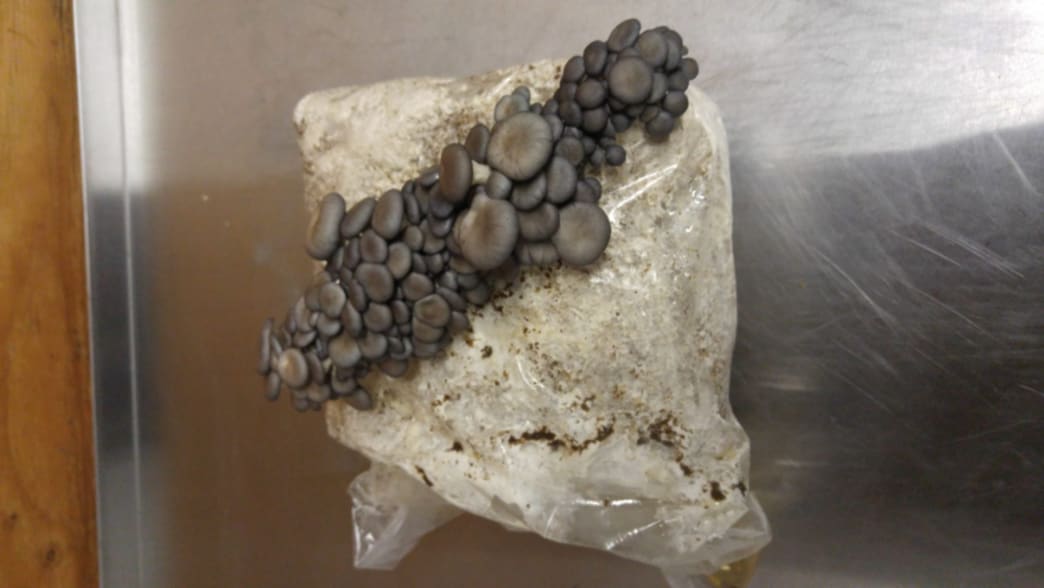Do you know about mushroom pinning? Learn all about it now and pick up a mushroom growing kit from us so you can watch the process for yourself!
Mushroom pinning is when little baby mushrooms start emerging from the substrate during the fruiting stage.
Below we discuss mushroom pinning in a few different scenarios that involve using our mushroom growing kits and our mushroom spawn.
Mushroom pinning with growing kits indoors
Once they arrive in the mail, you can start your mushroom growing kits by cutting holes in the plastic and misting the growing kit where the holes have been cut (the process is different for shiitake mushroom kits). Mist the kit with a spray bottle or your kitchen sink’s nozzle attachment to ensure humidity is high enough and do this two or three times each day. It is recommended to keep a temperature and humidity gauge where the kit is located to ensure it is experiencing the ideal conditions. Doing so will help you reach max yields.
After about a week you will see the mushroom pinning start. The mushroom pinning is a great sign of success! You will be one step closer to your first flush of fresh, organic mushrooms!
Continue spraying the kit each day, but try to avoid directly spraying the fruiting bodies once they get bigger. You should be able to have your first flush within two weeks of starting the mushroom kit. Once you have harvested the first flush of mushrooms, you should let the kit rest for 2-3 weeks. The resting process is like recharging a battery. All you have to do is leave the block alone in an area that has good airflow. You will want the kit to dry out during the resting stage.
Understanding shiitake mushroom pinning while fruiting
Now let’s take a look at shiitake mushroom pinning in a fruiting room. The fruiting room is a place of transformation on any mushroom farm. Mycelial blocks turn into sellable fungal fruit bodies.
During the fruiting stage, it is important to monitor these four key environmental parameters: CO2 levels, lighting, humidity, and temperature. Adjust accordingly to maintain optimal conditions for fruiting.
An interesting piece about mushroom pinning is that the size and quantity of mushrooms can be seen from the initial mushroom pinning. If there is an excessive amount of pins that create little mushrooms, then some pins can be knocked off to encourage fewer but larger mushrooms.
During these first four days, air exchange and high humidity are extremely helpful to create a good mushroom pin set. If CO2 levels are above 1000-1200 ppm, pin set can be adversely affected. Similarly, if relative humidity drops below 70%, the mushroom pinning can be also adversely affected.
To maintain high humidity while growing shiitakes from blocks, we recommend spraying the shiitake blocks directly two times per day for the first three or four days of fruiting, until the mushroom pins are the size of a thumb nail. After the initial mushroom pinning, the mushrooms will be a little more durable and can deal with environmental fluctuations easier.
The best measure of proper environmental parameters is the mushrooms themselves. If the mushrooms look good, taste good, and store well, then the environmental parameters are great!
In general, temperatures between 55-70 degrees Fahrenheit, CO2 levels below 1200, sufficient lighting to read comfortably, and humidity between 80-95% are ideal. Shiitakes, however, are much more tolerant to high CO2 levels and low light than oyster mushrooms.
Growing Mushrooms Using Supplemented Sawdust Blocks – Outdoors
Outdoor fruiting on supplemented sawdust blocks is one of the easiest methods to start growing mushrooms. Very little infrastructure or space is needed to successfully grow mushrooms outdoors. Several different species including shiitake, lion’s mane, chestnut, and pioppino can easily be fruited from blocks outside.
The mushroom blocks we sell, which we display below, can be used for growing mushrooms outdoors from April-November in northern climates. Note: It is not recommended to grow oyster mushrooms in this fashion as they get larvae in them when grown outside.
Depending on how the sawdust blocks are procured and what method of shocking is used, the outdoor fruiting area will look a little different. This process can be as easy as putting blocks in the woods and letting them fruit.
A good place to do this is underneath either deciduous or evergreen trees. Clear away the dead organic material on the ground. You can then use a pallet to keep the mushroom blocks off the ground. You can also do it directly on the soil if you’d like, however they may end up getting a little dirty, especially after it rains. Once you have your blocks down, leave space between each one so there is ample room for fruiting.
As mentioned above, begin to mist the blocks two to three times each day for the first four days. Some mushroom farmers will create a low tunnel made of plastic or metal hoops and greenhouse plastic that covers the pallets. This helps to increase humidity conditions, especially during the mushing pinning phase.
---------
Content & Optimization by Chris Sturk

